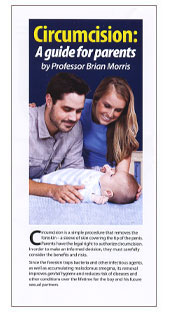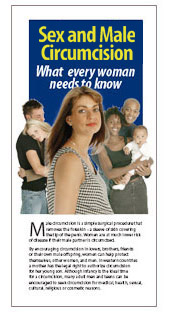Circumcision Cost-Benefit
Brief summary: Early infant male circumcision is cost-effective. A study by Johns Hopkins researchers found that for infections (UTI and STIs) alone, if early infant male circumcision declined from current levels in the US of approx. 80% overall to a level of 10%, there would be an escalation in costs to over US$4.4 billion across 10 annual birth cohorts [Kacker et al. 2012]. The increase in expenditure was estimated as $313 per foregone male circumcision. Modelling studies have found cost savings initially generated by non-coverage of elective infant MC by Medicaid in Louisiana [Ortenberg & Roth, 2013] and Florida [Gutwein et al. 2013] were mitigated by increases in rate and expense of circumcisions required for medically reasons. The study in Louisiana study only considered the costs of later circumcisions for boys in the 0–5-year-old age range. The costs over the lifetime would thus represent a far greater financial burden. The study in Florida found Medicaid defunding actually led to a 6-fold rise in publicly-funded circumcisions at a cost of US$112M [Gutwein et al. 2013]. As a result of these findings, in 2016 Florida restored Medicaid coverage [Attorneys 2014].
Earlier published estimates that have NOT fully taken into account ALL of the problems that afflict the uncircumcised have found that on average the amount per circumcision across all ages versus mean lifetime medical costs in those not circumcised either work out about the same or slightly favor circumcision [Ganiats et al., 1991; Lawler et al., 1991; Colby et al., 2001; Schoen et al., 2006]. That is, circumcision is cost-effective.
In one of these analyses it was stated that if the rate of surgical complications from circumcision was less than 0.6% or if risk of penile problems in uncircumcised males exceeded 17% (cf. the then perceived current baseline of 14%), then circumcision would be preferred on a cost and lifespan basis [Lawler et al., 1991].
A cost-analysis in 2006 stated ‘much of the initial cost of neonatal circumcision is eventually recovered when disease and the medical need (in 8.5%) for post-neonatal circumcision are prevented [Schoen et al., 2006]. This analysis was very conservative, in that it allowed for savings if the amount paid for circumcision was instead put in a bank account and allowed to earn 3% interest for the period before the medical condition arose (e.g., UTI 6 months, balanoposthitis/phimosis 10 y, HIV 40 y, invasive penile cancer 65 y), i.e., the future costs were discounted at an annual rate of 3% [Schoen et al., 2006]. It is of course more likely that the parents would spend the money saved by not having their boy circumcised on something else, rather than invest it in a savings account for the respective periods.
It should moreover, be noted that these analyses did not consider all conditions, for example, prostate cancer, conditions in the female partner such as chlamydia, cervical cancer and genital herpes, inflammatory dermatoses, physical, as well as sexual and other problems in uncircumcised men and their partners [Morris et al., 2006b]. When these conditions are factored in, then the cost of non-circumcision would vastly exceed that of circumcision [Morris et al., 2006b]. That is, there would be a very considerable positive cost-benefit.
For UTI, the treatment cost per outpatient UTI is $150 and per inpatient UTI is $2,200 [Schoen et al., 2006]. Based on a 1-year cumulative incidence of UTI in circumcised and uncircumcised boys of 0.22% vs 2.15%, respectively, the mean inpatient/outpatient facility costs of treatment are $703 vs $1,179 (i.e., taken together, cost is 17 times higher for the uncircumcised) [Schoen et al., 2000a].
Cost to treat balanoposthitis and phimosis in the 3.5% of uncircumcised males affected is US$150 per case [Schoen et al., 2006].
Cost of treating penile cancer was stated in 1991 as $5000 per year [Lawler et al., 1991]. And even back in 1980, the cost for treatment and lost earnings in a man of 50 with cancer was $103,000 [Harturian et al., 1980]. In 2006 the lifetime cost just for treatment of penile cancer were estimated as $7,500 [Schoen et al., 2006].
In the case of prostate cancer alone, annual cost (US$3 billion) is over 10 times the cost of the 2 million neonatal circumcisions each year in the USA. The cost of treatment by radiation only averages $13,823 per patient and by radical prostatectomy is $12,250 [Gregg, 2000]. The cost, in the USA, for treating the extra cases of penile cancer arising from lack of circumcision has been estimated as $0.8-1.1 billion [Morris et al., 2007].
For HIV/AIDS treatment one estimate of cost per case in the USA is US$45,198 [Schoen et al., 2006]. Another found that lifetime treatment costs, discounted to time of birth, and assuming an average age of infection of 36 years, amounted to US$113,381, and that cost of circumcision offset these costs favorably [Sansom et al., 2007]. A later report by this group found that for an overall circumcision rate of 79% in the USA, neonatal circumcision reduced the lifetime risk of HIV amongst all males by 16% (8% in white males and 21% in black males) [[Sansom et al., 2010]. It was also cost-saving, even after discounting at a rate of 3% per year. The net cost of newborn circumcision per quality-adjusted life year (QALY) saved was $87,792 for white males and was even better for black and Hispanic males. How much greater then would be the cost-benefit for settings elsewhere in the world where newborn male circumcision is lower (for example only 10%, plus or minus, in Australia, the U.K., Europe, South America, India, China and many other Asian countries)? And how much greater would be the savings by inclusion of other conditions and diseases prevented by neonatal male circumcision, where the paper states: "Our analysis has two limitations that, if considered, would make neonatal circumcision [even] more cost-effective. First, our analysis did not include other health benefits associated with the procedure. Lack of male circumcision has been associated with increased incldence of sexually transmitted ulcer disease, infant urinary tract infections, penile cancer, and cervical cancer in the female partners of uncircumcised men". In high HIV areas in particular, for HIV prevention later in life alone, neonatal circumcision would save more money in the long term than it costs [Martin et al., 2007; Auvert et al., 2008; Wamai et al., 2008][[Binagwaho et al., 2010].
If one adds all of the other conditions in males (shown in the diagram preceding ‘Conclusions’ at end) cost is far greater than 10-fold.
Then, if one adds to this the costs in females (cervical cancer, pelvic inflammatory disease, infertility, ectopic pregnancy), the medical cost of lack of circumcision becomes astronomical [Morris et al., 2006b].
On top of this is the emotional cost to those affected and their families.
The reader should be made aware that one particular ‘cost-utility analysis’ by an anti-circ activist [Van Howe, 2004] has been severely criticized [Gray, 2004] and should be disregarded as erroneous.
Everyone has a right to ensure a healthy penis. Many who seek a doctor to circumcise themself or their child may be doing so because of a medical problem. However, most merely want what is best, be it prevention of future problems, or esthetics. These are all valid reasons for requesting circumcision. A medical complaint, even if minor, can be expensive and so circumcision early in life to prevent this happening should help reduce the overall cost by providing a return on a claim to a health insurance provider, if not covered by the health system of the country in which it is done



